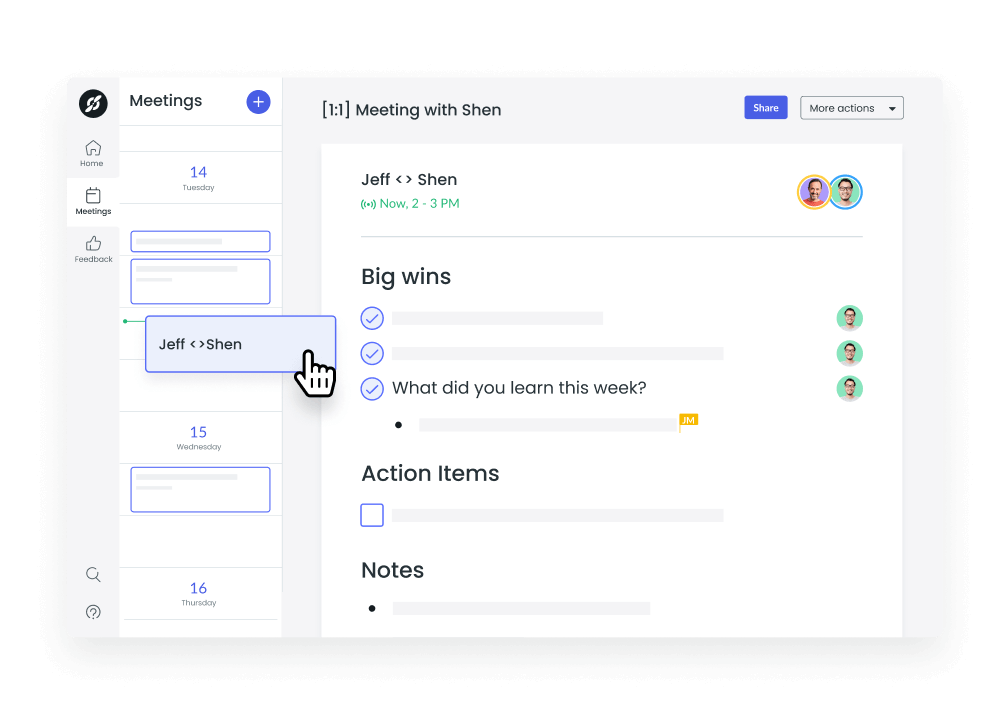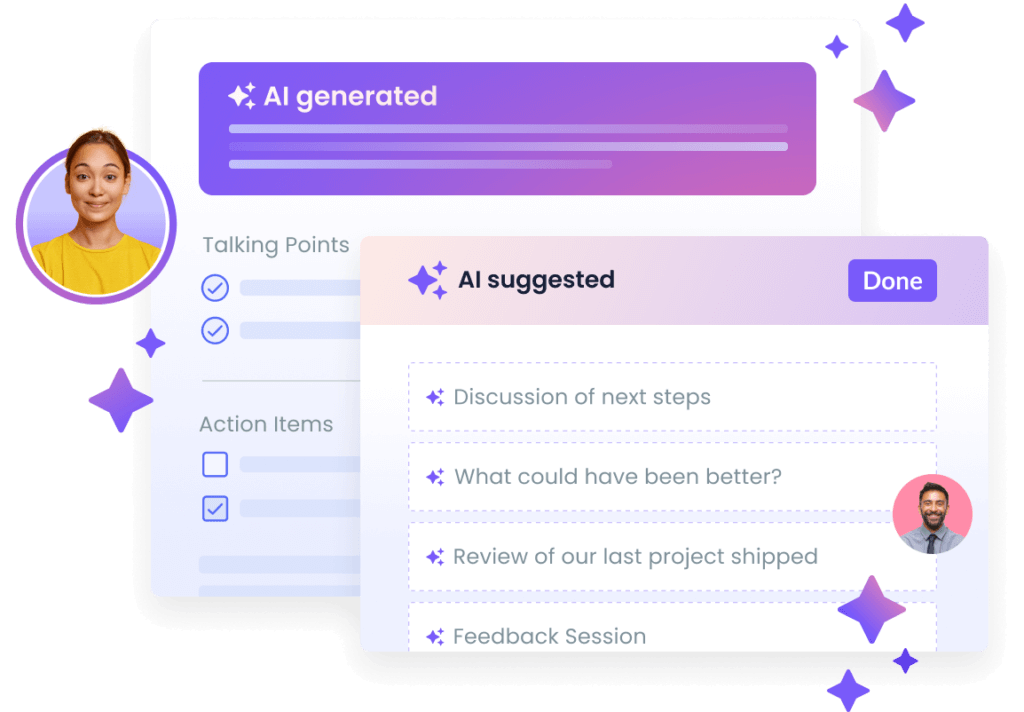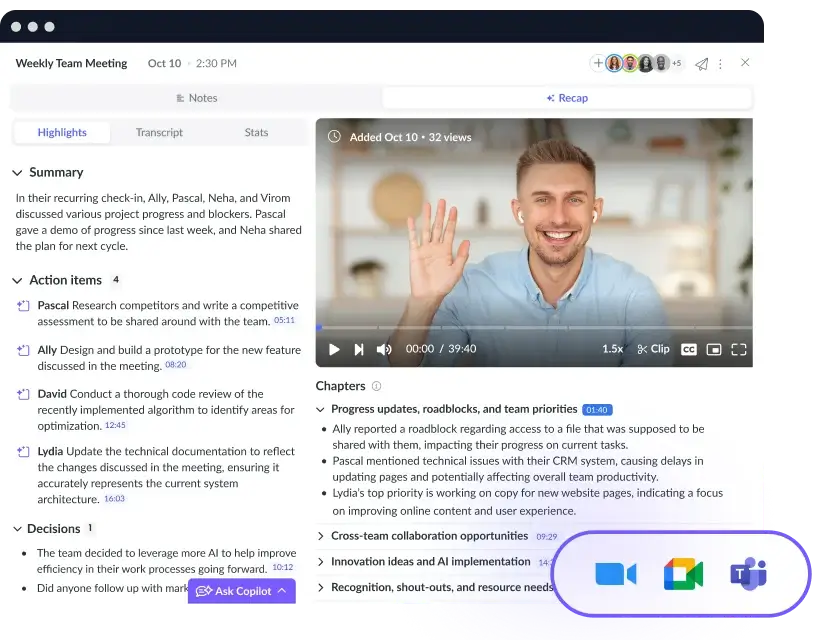One-on-One Emails: Step-by-Step Guide and Examples
Set the stage for a productive one-on-one meeting by including these key details in your pre-meeting emails.
One-on-one meetings are the backbone of effective management. As a dedicated time in your calendar for you to connect with direct reports, they’re one of your top tools for building trust, improving communication, and optimizing team performance. Companies like Deloitte, Adobe, Microsoft, and IBM have even gone so far as to replace annual reviews with frequent check-ins.
For one-on-one meetings to be successful, however, you and your team members need to invest some energy upfront and come prepared. The first step to a focused, productive discussion is to write an effective one-on-one email ahead of time to your direct report. Read on for a detailed guide and one-on-one email templates to help you level up your next meeting invitations.
- The purpose of one-on-one emails
- Crafting an effective one-on-one email
- Examples of one-on-one emails
- How Fellow can improve your one-on-one meetings
The purpose of one-on-one emails
One-on-one emails are important for setting clear expectations before your meeting takes place. In the meeting invite, you’ll establish the meeting purpose, outline discussion topics, and provide key meeting details in preparation for a meaningful conversation. Including the meeting agenda will encourage employees to do some pre-meeting reflection and contribute additional talking points. In addition to aiding preparation, effective one-on-one emails establish the intent behind your meeting. Framing it as an opportunity for two-way feedback and support can turn your discussion from a stressful experience for employees into one they look forward to.

Take control of your one-on-one meetings
Collaborate on meeting agendas, assign action items, get suggested conversation topics, and exchange feedback. Fellow is the one-on-one meeting app your team will love.
Crafting an effective one-on-one email
- Use a descriptive subject line
- Write a personalized greeting
- Add an introduction
- Define the meeting purpose
- Outline topics to discuss
- Provide meeting details
- Make a preparation request
- Include a supportive note
- Close with a professional sign-off
1Use a descriptive subject line
Start your email by writing a subject line that’s clear and concise. Your employees may be experiencing email overload; make sure to include key information about your meeting in the subject line so it stands out in their inbox. For example, if you need to schedule the meeting by a certain time or date, mention that in the subject line so it gets prioritized. Here are some examples:
- [Employee Name] + [Manager Name] One-on-One
- Let’s schedule a check-in for next week
- Please Reply by EOD: Meeting to review progress on [Project Name]
2Write a personalized greeting
One-on-one meetings can be intimidating for employees, so you can use your email greeting to set a relaxed tone. Open the body of your email with a personalized greeting that strikes a balance between being professional and friendly. Adding a thoughtful “I hope you enjoyed your weekend” or “Congratulations on accomplishing [X] last week” can show you care. You can even add a touch of humor and use, “Just what you want: another email!”
3Add an introduction
Next, briefly explain the reason for your email. Manager-employee communication around one-on-ones sets the stage for a productive conversation, so make sure to keep your language positive. If it’s your first time having a one-on-one with the employee, you can share an overview of the benefits of one-on-one meetings to encourage buy-in and help them feel excited about your conversation. You can also highlight the importance of one-on-ones so they know to prioritize the meeting and do the necessary prep work. Even if there’s nothing on the agenda, you should avoid canceling one-on-ones and instead use the time for an open-ended discussion.
4Define the meeting purpose
Including a clearly outlined purpose is essential for your one-on-one meeting invitation. You can let your employees know the reasons for your one-on-ones, including getting to know them better, learning about their challenges, discussing career development, and creating a safe space to exchange feedback. Sometimes, your one-on-ones might also have a more specific purpose, such as to review your employee’s goals for the next quarter and how you can support them.
Fellow helps ensure every meeting has a defined purpose. With the Meeting Guidelines feature set, when a meeting is being created, meeting organizers are prompted to add a meeting purpose to the description of the meeting to help boost meeting engagement.
5Outline topics to discuss
Summarize the topics you’d like to cover so your employees can reflect on them ahead of time. Talking points for your one-on-ones might include:
- Things that have gone well recently
- New learnings or takeaways
- Current priorities
- Challenges and concerns
- Feedback on your management style
- Career development
It’s important to note that your one-on-ones should be shaped by your employees, not just by you as the manager. With Fellow, you can create a collaborative meeting agenda so both you and your employees can add talking points, comments, action items, and more for a two-way discussion. You can also use Fellow’s AI suggested agendas to instantly build custom recommendations of agenda topics and talking points for your one-on-ones.
6Provide meeting details
Don’t forget to list the meeting’s date, time, duration, and location or link to join. If you’re going to send a calendar invite, mention that it will follow the email. In terms of location, meeting up in person can be a great way to build rapport when possible, and you don’t need to stick to the office—you can also go for a walk or head to a local coffee shop!
You should also consider scheduling the meeting as a recurring one-on-one. Management experts recommend meeting weekly since a lot of the value for you and your employees will come from regular conversations.
7Make a preparation request
One-on-one meetings are a shared responsibility between you and your employees. In your email, clearly outline a few things your employee can do ahead of time—for example, prepare some thoughts or questions, review project details, add items to the agenda, or read the notes from your previous meeting. Sending them a list of topic examples can also help them identify areas they’d like to discuss. Check out this list of one-on-one meeting questions you can share with your employees.
8Include a supportive note
Expressing support in your email can help reassure employees so they don’t feel intimidated about the meeting. After all, the main purpose of your one-on-ones is for you to support and coach your team. Let them know you’re looking forward to discussing their journey within the company and that your meeting is an opportunity for them to ask questions and provide feedback. Showing support will encourage your employees to open up in your discussions and foster a culture of trust.
9Close with a professional sign-off
End your one-on-one meeting invitation with a professional sign-off showing enthusiasm for the next steps. Here are some examples:
- Looking forward to our conversation!
- Congratulations on your recent progress — look forward to discussing your goals
- Excited to tackle [challenge] with you!
- Thanks in advance for setting aside some time to connect
- I appreciate all your hard work on [project name] lately — speak soon!
Examples of one-on-one emails
Fellow’s meeting templates make writing one-on-one emails simple by helping you identify key discussion topics, divide your conversation into different themes, and identify best practices for one-on-one meetings, such as discussing priorities and professional growth. Fellow also makes it easy to keep track of past discussions with employees so you can refer back to them when scheduling your next check-ins by email.
One-on-one email template for managers
Here’s a one-on-one email template you can use to schedule a meeting with a direct report.
Hi [Employee’s Name],
I hope this message finds you well. I’d like to schedule our first one-on-one meeting to touch base on your experiences so far, discuss your role and objectives, and explore how I can support your career development.
Let’s plan to discuss the following topics:
- Your reflections on the first month with us
- Progress on current projects
- Career aspirations and skills development
Please find below the details for our meeting:
Date: [Date]
Time: [Time]
Location: [Office room/Video call link]
Duration: Approximately [X] minutes
I encourage you to bring any questions or topics you’d like to address in our meeting. Your input is invaluable, and I’m here to support you.
Looking forward to our conversation!
Best regards,
[Your Name]
One-on-one email template for employees
Here’s a one-on-one email template you can use to schedule a meeting with a colleague.
Hi [Employee’s Name],
I hope you’re having a great week! I’d like to schedule a one-on-one meeting to get to know you better, learn more about your professional experience, and explore how we can support each other in our roles.
I’ve thought of some topics we could discuss:
- An overview of our roles with the company and professional backgrounds
- Our preferred work and communication styles
- How we could work effectively together on upcoming projects
Please find below the details for our meeting:
Date: [Date]
Time: [Time]
Location: [Office room/Video call link]
Duration: Approximately [X] minutes
Please let me know before the meeting if there are additional topics you think we should discuss. I look forward to learning more about you and discussing ways we can collaborate effectively.
Excited to tackle future projects together!
Best regards,
[Your Name]
How Fellow can improve your one-on-one meetings
Fellow makes it easy for you to have productive and meaningful one-on-one meetings with your direct reports. Get started with collaborative meeting agendas to help your team prepare ahead of time, inspire a balanced discussion, and record action items so nothing gets lost. You and your employees can also view a history of past conversations so you can pick up exactly where you left off and review progress since your last meeting.
With Fellow’s Objectives tool, your team members can record their professional goals so you can help them stay on track to support their career development.
Finally, Fellow’s feedback tool will help you build a culture of regular two-way feedback and foster transparent manager-employee communication that promotes continuous improvement.

Instantly build thoughtful meeting agendas with AI
Harness the power of AI to save time, get inspired, and enable efficient meeting preparation. Get AI-generated suggested agendas, topics, and talking points right where your meetings happen.
Parting advice
Writing effective one-on-one emails is the preliminary step toward one-on-one meetings that encourage personal and professional growth on your team. Your email affects how your employees view your meetings, how prepared they are, and how they contribute to the conversation. It’s important to put yourself in your employees’ shoes and consider how you can best support them before, during, and after every one-on-one. Make sure to read our guide on The Art of the One-on-One Meeting and get started with Fellow to support your next team meetings.













